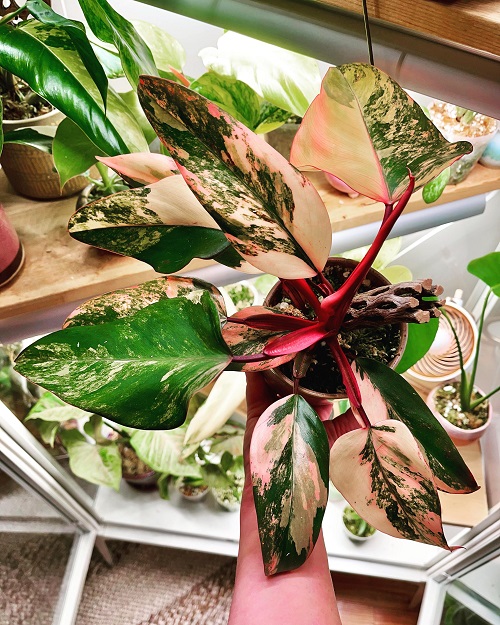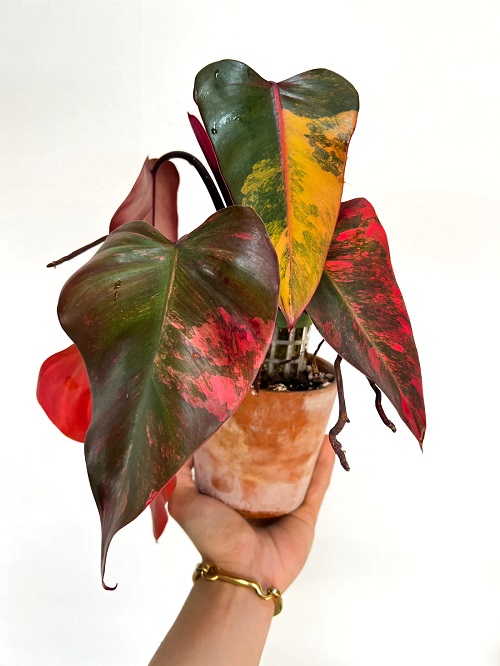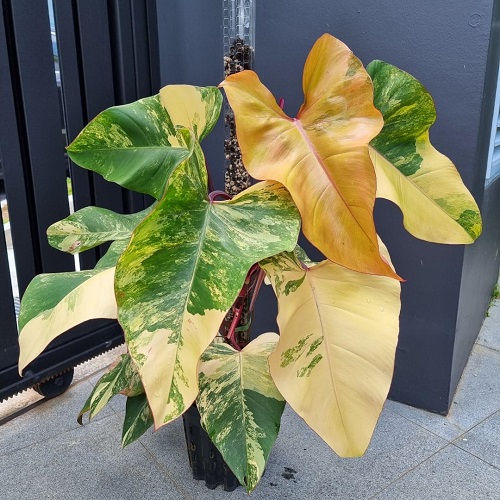Strawberry Shake Philodendron is a plant to have if you love bright colors with combinations! Keep on reading to learn how to grow it!

Follow these tips for successfully growing Strawberry Shake Philodendron indoors and enjoy its unique colors in your home.
Learn Growing Philodendron selloum Easily here
Strawberry Shake Philodendron Information
The plant is scientifically known as Philodendron ‘Strawberry Shake’ or Philodendron bipinnatifidum ‘Strawberry Shake,’ is a popular tropical houseplant known for its striking foliage.
The exact origin of the Strawberry Shake Philodendron is not clear, but it is believed to be a hybrid or cultivar derived from the Philodendron bipinnatifidum species. Philodendron plants are native to the tropical regions of Central and South America.
The plant is prized for its unique foliage. The leaves are large, glossy, and deeply lobed, with a vibrant mix of colors. The new leaves emerge as bright pink or reddish-pink, gradually maturing to a blend of green and creamy-white. The contrasting colors give the plant its strawberry-like appearance, hence the name “Strawberry Shake.”
Learn Everything About Growing White Princess Philodendron here
Propagating Strawberry Shake Philodendron
The easiest way to propagate the Strawberry Shake Philodendron is through stem cuttings.
- Choose a mature, healthy stem from the parent Strawberry Shake Philodendron that is at least 4-6 inches long and has several nodes (the points where the leaves emerge).
- Using clean, sharp pruning shears or a knife, make a clean cut just below a node on the selected stem. Remove any lower leaves near the bottom of the cutting, leaving a few leaves at the top intact.
- Allow the cut end of the stem to dry and callus for a few hours or overnight. This helps to prevent rotting when the cutting is planted.
- Prepare a small pot with well-draining soil, such as a mix of perlite and peat moss or a commercial potting mix suitable for houseplants. Make a small hole in the soil with your finger or a pencil and insert the cut end of the stem into the hole. Gently press the soil around the cutting to hold it in place.
- Place the potted cutting in a warm, bright location with indirect light. Avoid direct sunlight, as it can be too intense for the young cutting. Maintain a temperature between 65°F (18°C) and 75°F (24°C).
- To increase humidity around the cutting and promote successful rooting, you can cover the pot with a clear plastic bag or place it in a mini-greenhouse. This helps to create a humid microenvironment. Mist the cutting occasionally to keep the foliage moist.
- Over the next few weeks, the cutting will develop roots. Check for root growth by gently tugging on the cutting after a few weeks. If you feel resistance, it indicates that roots have formed.
Propagate Any Plant Cutting Quickly Using this Trick
Requirements for Growing Strawberry Shake Philodendron 
Location
To preserve its vibrant coloration, the Strawberry Shake Philodendron thrives on abundant bright and indirect light. However, it’s important to protect its delicate leaves from direct sunlight.
Ideally, place the plant in a spot with bright, indirect light near a sunny window, ensuring the sun’s rays never directly touch its foliage.
Inadequate light can lead to a loss of variegation and the development of unattractive, elongated growth, so maintaining the right lighting conditions is essential for this plant’s health and visual appeal.
Soil
Strawberry Shake Philodendron thrives in a well-draining and airy soil mix. An ideal choice is a high-quality commercial potting soil blended with perlite, providing the necessary drainage.
Find out some Helpful Hacks to Improve Your Garden Soil for Free here
It is crucial to ensure that the plant container has sufficient drainage holes to prevent waterlogging and promote healthy root development.
Water
The Strawberry Shake Philodendron loves a moderate amount of water, making it crucial to avoid overwatering to prevent root rot and fungal infections.
To determine when to water, simply check the top few inches of soil using your finger and only proceed when the soil’s surface is dry.
While the plant isn’t drought-tolerant, it is more forgiving compared to many other plants. It’s advisable to be cautious underwater rather than risk overwatering, ensuring the plant’s well-being.
Look out for these Sure Shot Signs of Underwatered Plants
Temperature and Humidity
The Strawberry Shake Philodendron thrives in average to warm temperatures, ideally between 65°F (18°C) and 90°F (32°C). It can tolerate slightly cooler temperatures down to 55°F (13°C) but avoid exposing it to cold drafts or temperatures below that threshold.
This Philodendron prefers moderate to high humidity levels. Aim to maintain humidity levels between 40% and 60% to provide the plant with adequate moisture. You can increase humidity by using a humidifier, placing a tray filled with water near the plant, or grouping plants together to create a microclimate of higher humidity.
Here are 10 Ways To Increase Humidity For Houseplants That Work
Strawberry Shake Philodendron Care

Fertilizer
To ensure optimal growth, the Strawberry Shake Philodendron requires regular fertilization, typically once a month during the growing season.
A balanced liquid fertilizer is all you need to keep the plant thriving. Use it once a month after diluting it to 1/2 of its strength.
Want to Make Organic Fertilizers from Kitchen Scraps? Click here
Pruning
When it comes to pruning, the Strawberry Shake Philodendron does not require any specific maintenance. However, like all plants, it is advisable to remove dead or dying leaves to prevent the plant from expending unnecessary nutrients.
Once a leaf starts to turn yellow, it is unlikely to recover and should be pruned to maintain the overall health and appearance of the plant.
Pests and Diseases
Like many houseplants, the plant is prone to common pests and diseases. Be vigilant for signs of mealybugs, scale, fungus gnats, and thrips. Should you spot any pests, promptly address the issue by utilizing natural or commercial insecticides until the problem is resolved.
Additionally, taking preventive measures by regularly treating your plant can help deter infestations before they occur.
Click here to learn the Amazing Natural Pesticide Recipe that can Kill any Pest
Two significant diseases to be mindful of for the Strawberry Shake Philodendron are root rot and fungal leaf spot diseases.
To prevent root rot, ensure proper drainage. In the case of fungal leaf spots, use a fungicide and isolate affected plants. Always inspect new plants to avoid introducing infections into your home.



